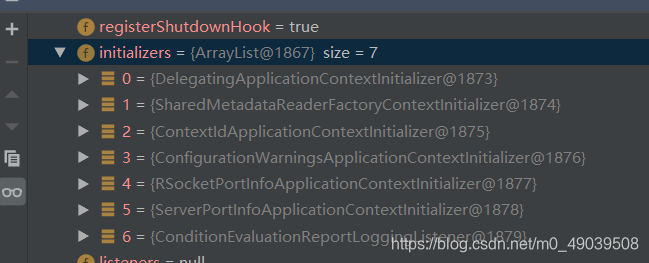
本文共 9406 字,大约阅读时间需要 31 分钟。
springboot应用创建初始化流程和启动过程
文章目录
创建SpringBoot应用创建初始化流程分析
分析
我们现在启动类上的xxx.run()语句上打断点,并使用DEBUG,如下
 我们
我们Step Into进入org.springframework.boot.SpringApplication#run(java.lang.Class<?>, java.lang.String...)方法  再
再Step Into进入org.springframework.boot.SpringApplication#run(java.lang.Class<?>[], java.lang.String[])方法  再
再Step Into进入org.springframework.boot.SpringApplication#SpringApplication(java.lang.Class<?>...)方法  再
再Step Into进入org.springframework.boot.SpringApplication#SpringApplication(org.springframework.core.io.ResourceLoader, java.lang.Class<?>...)构造器 
this.resourceLoader = resourceLoader;:资源加载器Assert.notNull(primarySources, "PrimarySources must not be null");:断言是否有主配置类;this.primarySources = new LinkedHashSet<>(Arrays.asList(primarySources));:将断言获得的主配置类信息保存this.webApplicationType = WebApplicationType.deduceFromClasspath();:判断当前WEB应用的类型;setInitializers((Collection) getSpringFactoriesInstances(ApplicationContextInitializer.class));:找初始化器ApplicationContextInitializer,因为通过getSpringFactoriesInstances()方法,所以会去spring.factories文件中去找该类型的组件和其相关的值setListeners((Collection) getSpringFactoriesInstances(ApplicationListener.class));:找应用监听器ApplicationListener,因为通过getSpringFactoriesInstances()方法,所以会去spring.factories文件中去找该类型的组件和其相关的值this.mainApplicationClass = deduceMainApplicationClass();:决定那个是我们的主程序
再一直Step Over到如下位置
 再
再Step Into进入org.springframework.boot.WebApplicationType#deduceFromClasspath方法  再
再Step Over到如下位置  因此可以看出当前应用的类型是Servlet
因此可以看出当前应用的类型是Servlet 再Step Over到如下位置
 此时我们会发现
此时我们会发现this.initializers下就有7个Initializer,如下:  再
再Step Over到如下位置  此时我们会发现
此时我们会发现this.listeners下就有11个listener,如下: 
结论
springboot应用创建初始化流程(从上到下)
- 通过
ClassUtils判断当前应用的类型,一般是判断出的是Servlet; 初始启动引导器bootstrappers,去spring.factories文件中去找org.springframework.boot.Bootstrapper类型的组件;- 找
初始化器ApplicationContextInitializer,会去spring.factories文件中去找该类型的组件和其相关的值; - 找
应用监听器ApplicationListener,会去spring.factories文件中去找该类型的组件和其相关的值 - 在SpringBoot中,只要看到了
getSpringFactoriesInstances(xxx)方法,就表示去spring.factories文件中去找xxx类型的组件
SpringBoot应用启动过程分析
分析
首先在如下图位置设置断点,并以DEBUG运行
 然后一直
然后一直Step Into至如下位置  再
再Step Into至org.springframework.boot.SpringApplication方法  然后
然后Step Out该方法  再
再Step Into进入==org.springframework.boot.SpringApplication#run(java.lang.String...)方法== 
StopWatch stopWatch = new StopWatch();停止观察器
StopWatch 的启动
Step Over至如下位置
 再
再Step Into进入org.springframework.util.StopWatch#start()方法  再次
再次Step Into进入org.springframework.util.StopWatch#start(java.lang.String)方法,并一直Step Over至如下位置  可以看到
可以看到StopWatch在调用start()方法后会保存任务的名称、项目启动的时间(纳秒计) 进入HEADLESS模式
再Step Over至如下位置
 再
再Step Into进入org.springframework.boot.SpringApplication#configureHeadlessProperty方法 
SYSTEM_PROPERTY_JAVA_AWT_HEADLESS是什么?我们跳转到该变量,发现:private static final String SYSTEM_PROPERTY_JAVA_AWT_HEADLESS = "java.awt.headless"; java.awt.headless是什么?表示让当前应用进入HEADLESS模式,即“自力更生”模式;
获取所有的运行监听器SpringApplicationRunListeners
再Step Over到如下位置
 我们
我们Step Into进入org.springframework.boot.SpringApplication#getRunListeners方法  然后一直
然后一直Step Over到如下位置 
getSpringFactoriesInstances(SpringApplicationRunListener.class, types, this, args)表示从spring.factories文件中找SpringApplicationRunListener类型的组件; starting所有的运行监听器SpringApplicationRunListeners
我们Step Over至如下位置

Step Into进入org.springframework.boot.SpringApplicationRunListeners#starting方法  可以发现该方法是遍历所有的
可以发现该方法是遍历所有的SpringApplicationRunListeners类型的组件,并调用它们的starting()方法(starting()方法表示告知系统正在启动) 保存命令行参数
Step Over至如下位置

args,即命令行参数,相当于保存所有的命令行参数 准备基础环境
再Step Over至如下位置

Step Into进入org.springframework.boot.SpringApplication#prepareEnvironment方法 
返回或创建基础环境信息
我们Step Into进入org.springframework.boot.SpringApplication#getOrCreateEnvironment方法

配置环境
一直Step Over至如下位置

Step Into进入org.springframework.boot.ApplicationArguments#getSourceArgs方法  表示配置参数
表示配置参数 再Step Over到如下位置
 然后
然后Step Into进入org.springframework.boot.SpringApplication#configureEnvironment方法  添加
添加ConversionService(类型转换器) configurePropertySources(environment, args);:加载外部配置源
configureProfiles(environment, args);:激活Profile
将配置好的环境信息绑定(保存)
Step Over至如下位置

所有的SpringApplicationRunListeners执行environmentPrepared方法
Step Over至如下位置

Step Into进入org.springframework.boot.SpringApplicationRunListeners#environmentPrepared方法  可以看到遍历所有的
可以看到遍历所有的SpringApplicationRunListener类型的组件,并执行environmentPrepared方法,表示通知所有的监听器当前环境准备完成; 绑定环境至SpringApplication
Step Into至如下位置

配置需要忽略的Bean信息
Step Over至如下位置

打印Banner
Step Over至如下位置

创建IOC
Step Over至如下位置
 然后
然后Step Into进入org.springframework.boot.SpringApplication#createApplicationContext方法  可以看到会根据当前应用的类型创建指定的IOC
可以看到会根据当前应用的类型创建指定的IOC 准备IOC的基本信息
Step Over至如下位置

Step Into进入org.springframework.boot.SpringApplication#prepareContext方法 
context.setEnvironment(environment);:将基础环境信息保存到IOC中postProcessApplicationContext(context);:保存IOC容器的后置处理(包括注册组件<beanNameGenerator>、读取配置文件的资源的资源加载器<resourceLoader>、准备类型转换器<addConversionService>)applyInitializers(context);:应用初始化器listeners.contextPrepared(context);:
保存IOC的后置处理流程
Step Into进入org.springframework.boot.SpringApplication#postProcessApplicationContext方法
 可以看到:保存IOC容器的后置处理包括注册组件<
可以看到:保存IOC容器的后置处理包括注册组件<beanNameGenerator>、读取配置文件的资源的资源加载器<resourceLoader>、准备类型转换器<addConversionService> 应用初始化器
Step Over到如下位置

Step Into进入org.springframework.boot.SpringApplication#applyInitializers方法 
getInitializers():SpringBoot启动时再spring.factories文件中的ApplicationContextInitializer类型的组件 可以看到是遍历所有的ApplicationContextInitializer类型的组件并调用它们的initialize()方法,来对IOC容器进行初始化的扩展
所有运行监听器SpringApplicationRunListeners调用其contextPrepared()方法
Step Over至如下位置

Step Into进入org.springframework.boot.SpringApplicationRunListeners#contextPrepared方法  可以看到调用了所有
可以看到调用了所有运行监听器SpringApplicationRunListeners调用其contextPrepared()方法 获取Bean工厂,并注册一些单实例的组件
Step Over至如下位置

所有运行监听器SpringApplicationRunListeners调用其contextLoaded()方法
Step Over至如下位置

Step Into进入org.springframework.boot.SpringApplicationRunListeners#contextLoaded方法  可以看到调用了所有
可以看到调用了所有运行监听器SpringApplicationRunListeners调用其contextLoaded()方法 刷新IOC容器
Step Over至如下位置

Step Into进入org.springframework.boot.SpringApplication#refreshContext方法  再
再Step Over至如下位置 
Step Into进入org.springframework.boot.SpringApplication#refresh(org.springframework.context.ApplicationContext)方法,并Step Over至如下位置  然后再一直
然后再一直Step Into至如下位置  可看到此时就是Spring容器经典的初始化容器过程,创建容器中的所有组件
可看到此时就是Spring容器经典的初始化容器过程,创建容器中的所有组件 IOC容器刷新完成后
Step Out至如下位置

停止停止观察器StopWatch
Step Over至如下位置

Step Into进入org.springframework.util.StopWatch#stop方法  可以看到该方法包括了计算项目
可以看到该方法包括了计算项目任务信息、启动时间(纳秒计)等的操作 所有运行监听器SpringApplicationRunListeners调用其started()方法
Step Over至如下位置

Step Into进入org.springframework.boot.SpringApplicationRunListeners#started方法  可以看到所有的
可以看到所有的运行监听器SpringApplicationRunListeners调用其started()方法 调用所有的Runners
Step Over至如下位置

Step Into进入org.springframework.boot.SpringApplication#callRunners方法 
runners.addAll(context.getBeansOfType(ApplicationRunner.class).values());:获取容器中的ApplicationRunner类型的组件runners.addAll(context.getBeansOfType(CommandLineRunner.class).values());:获取容器中的CommandLineRunner类型的组件AnnotationAwareOrderComparator.sort(runners);:合并上面两种获取的组件,并按照@Order注解排序for (Object runner : new LinkedHashSet<>(runners)) {...}:遍历所有,然后通过ApplicationRunner类型和CommandLineRunner类型的不同调用对应的run()方法
如果上述存在异常,所有运行监听器SpringApplicationRunListeners调用其failed()方法




如果上述都没有异常,所有运行监听器SpringApplicationRunListeners调用其running()方法
Step Over至如下位置

Step Into进入org.springframework.boot.SpringApplicationRunListeners#running方法  可以看到所有
可以看到所有运行监听器SpringApplicationRunListeners调用其running()方法 部分源码
SpringApplicationRunListener的结构图如下:

ApplicationRunner接口 package org.springframework.boot;import org.springframework.core.Ordered;import org.springframework.core.annotation.Order;@FunctionalInterfacepublic interface ApplicationRunner { /** * Callback used to run the bean. * @param args incoming application arguments * @throws Exception on error */ void run(ApplicationArguments args) throws Exception;} CommandLineRunner接口
package org.springframework.boot;import org.springframework.core.Ordered;import org.springframework.core.annotation.Order;@FunctionalInterfacepublic interface CommandLineRunner { /** * Callback used to run the bean. * @param args incoming main method arguments * @throws Exception on error */ void run(String... args) throws Exception;} 结论
springboot应用启动过程(从上至下)
- 会创建并启动
停止观察器StopWatch,该观察器会保存任务的名称、项目启动的时间(纳秒计); - 让当前应用进入HEADLESS模式(
java.awt.headless,自力更生模式); - 获取所有的
运行监听器SpringApplicationRunListeners; - 遍历所有的
运行监听器SpringApplicationRunListeners,并依次调用它们的starting()方法,表示告知系统正在启动,为了方便所有的Listener进行事件感知; - 保存命令行参数
- 准备基础环境
- 返回或创建基础环境信息
- 配置环境信息
- 读取所有的配置源的配置属性值
- 绑定(保存)配置好的环境信息
- 遍历所有的
运行监听器SpringApplicationRunListeners类型的组件,并依次调用它们的environmentPrepared方法,通知当前环境准备完成; - 绑定环境至SpringApplication
- …
- 配置需要忽略的Bean信息
- 根据当前项目的类型创建IOC
- 准备IOC容器的基本信息
- 将基础环境信息保存到IOC
- IOC容器后置处理
应用初始化器applylnitializers- 遍历所有的
ApplicationContextInitializer类型的组件并调用它们的initialize()方法,来对IOC容器进行初始化的扩展
- 遍历所有的
- 所有
运行监听器SpringApplicationRunListeners调用其contextPrepared()方法 - 进行一系列的其他操作
- 所有
运行监听器SpringApplicationRunListeners调用其contextLoaded()方法
- 刷新IOC容器
- 实例化容器中的所有组件(通过Spring)
- IOC刷新完成后的操作
- 停止
停止观察器StopWatch - 所有
运行监听器SpringApplicationRunListeners调用其started()方法 - 调用所有的
Runners- 获取容器中的
ApplicationRunner类型的组件和CommandLineRunner类型的组件 - 合并上面两种获取的组件,并按照
@Order注解排序 - 遍历所有,然后通过
ApplicationRunner类型和CommandLineRunner类型的不同调用对应的run()方法
- 获取容器中的
- 如果以上有异常出现,会调用所有
运行监听器SpringApplicationRunListeners的failed()方法,表示告知系统进入失败状态;如果以上没有异常,会调用所有运行监听器SpringApplicationRunListeners调用其running()方法,表示告知系统进入运行状态; eners调用其contextLoaded()方法` - 刷新IOC容器
- 实例化容器中的所有组件(通过Spring)
- IOC刷新完成后的操作
- 停止
停止观察器StopWatch - 所有
运行监听器SpringApplicationRunListeners调用其started()方法 - 调用所有的
Runners- 获取容器中的
ApplicationRunner类型的组件和CommandLineRunner类型的组件 - 合并上面两种获取的组件,并按照
@Order注解排序 - 遍历所有,然后通过
ApplicationRunner类型和CommandLineRunner类型的不同调用对应的run()方法
- 获取容器中的
- 如果以上有异常出现,会调用所有
运行监听器SpringApplicationRunListeners的failed()方法,表示告知系统进入失败状态;如果以上没有异常,会调用所有运行监听器SpringApplicationRunListeners调用其running()方法,表示告知系统进入运行状态; - 如果调用
running()方法出现异常,同样也会调用failed()方法通知系统进入失败状态;
转载地址:https://blog.csdn.net/m0_49039508/article/details/117068472 如侵犯您的版权,请留言回复原文章的地址,我们会给您删除此文章,给您带来不便请您谅解!
发表评论
最新留言
关于作者
